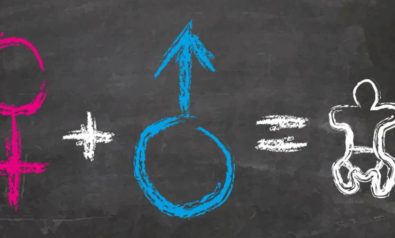It’s not the bondage that’s the problem with the upcoming blockbuster, but something more mundane.
Fifty Shades of Grey film opens this Valentine’s weekend to much fanfare but, perhaps tellingly, with few press previews in the United Kingdom. With one British cinema chain reporting advance ticket sales worth £1.3 million, it’s pretty clear the adaptation of E. L. James’ best-selling book is going to be critic-proof.
It is difficult to write about Fifty Shades without being caught up in excess: translated into 51 languages, more than 100 million copies sold, 50 million-plus views of the trailer on YouTube. This is the novel that has spiced up (heterosexual) marital bedrooms and led to its own range of sex toys. To cash in on the film’s release, British DIY retailer B&Q has advised staff to expect soaring sales of cable ties and duct tape. There’s even a limited edition Fifty Shades of Surf laundry detergent to help with the post-coital clean up.
From the trilogy’s sadistic billionaire to laundry detergent might seem like quite a leap. But at the heart of Fifty Shades’ success has been the juxtaposition of the apparent ordinariness of both the novel’s heroine, Ana Steele, and the middle-aged, middle-class mother who wrote it (originally as Twilight fan fiction) with the extraordinarily wealthy, extraordinarily sexy, extraordinarily messed-up Christian Grey.
Despite, or perhaps because of, its resolutely heterosexual address, the Fifty Shades phenomenon has been defined by women’s relationships with one another as much, if not more than, with men. This has clearly been played on in the portrayal of director Sam Taylor-Johnson ahead of the film’s release: another middle-aged mom, overlooked professionally after the birth of her four children, given a second chance by Fifty Shades.
Of course, there’s also been much criticism of the book and, now, the film. At times, this criticism has itself been steeped in a barely disguised misogyny directed toward the author, fans or director. This has, in turn, made it easier for Fifty Shades’ supporters to claim that the phenomenon is doing feminist work. So the challenge for feminist critics of Fifty Shades is to air our concerns without pandering to mainstream media’s penchant for pitting women against women, or being dragged into a discussion about the relative merits of particular sexual practices.
Love and Abuse
Looked at more closely, the sex in Fifty Shades turns out to be something of a distraction. One of the most resilient claims about the book — central to Universal’s Valentine’s release strategy for the film — is that it is, underneath all the distracting “kinky f**kery,” a love story.
I agree. This is not an endorsement, it is simply a statement about the kind of story it is. While the sex is certainly not irrelevant, it is love that is most consistently used as a justification for abuse outside the parameters of BDSM.
It is not surprising, then, that much of the criticism of Fifty Shades has come from feminists delivering frontline services to women fleeing domestic abuse. The most high-profile campaign against the film, hash-tagged #50dollarsnot50shades, encourages potential viewers to recognize this connection by donating the price of their cinema tickets to a local refuge.
Taylor-Johnson’s most recent interviews seem designed to get it back on safer ground: “Do feminists always have to be on top?” she asks. Despite the reality of her own struggles to get back “on top” professionally after the birth of her children, this is meant to be a sexual and not a social question.
It should go without saying that women (and men) can and do choose to engage in a spectrum of BDSM-related activities. If these choices are made between participants who have an equal standing in the negotiation, then I fail to see why this should be anyone else’s business.
But there’s the problem. Christian and Ana are not equals outside of their sexual relationship, and so the fantasy of sexual submission collides with a more brutal reality. I’m far less concerned with what Ana and Christian do in the bedroom (and in the bath, the elevator, the car, on the piano …) than how Christian’s controlling behavior outside of it not only determines the conditions of Ana’s “consent,” but is in itself a form of abuse.
He monitors what she eats and drinks, what she drives, where she works, what she wears, who she sees, what they do. More insidiously, he does all of this because he loves her, and his wealth legitimates and luxuriously brands his choices. It’s not for nothing that this has been dubbed “wealth porn.” What’s more, Christian’s controlling behavior is repeatedly shown to save Ana — from herself as well as from a stream of men whose intentions she dangerously misreads.
This is what feminists have long referred to as the male-protection racket. It’s the plot of countless romance novels whose naïve, young protagonists are paired with more worldly powerful men. Thirty years on, the debate over Fifty Shades has become more hedonistic while arguably serving an equally conservative function: the end destination is still heterosexual marriage and children, with other options quickly closed down.
Fifty Shades of Entitlement
Positioning herself firmly within the demographic the book has appealed to, James has repeatedly, if somewhat coyly, spoken of the pleasures of conducting her research for the novel’s sex scenes with her husband. The novel was her fantasy, written for herself in the first instance.
Whether individual women find new pleasure from butt plugs is not the point here. Rather, the novel’s engagement with broader debates about gendered violence and power cannot be fantasized away. After all, one of the constants across all three novels is Ana’s explicit labeling of Christian’s controlling behavior outside the bedroom as “stalking.” Yet she accepts that he does it because he loves her.
This is consistent with a wider cultural script in which obsessive male behavior and men’s sense of entitlement to women is still too often legitimated, with concrete, material effects on women’s safety and lives. Ana agrees to marry Christian at aged 21, and just weeks into their relationship, because he needs reassurance that she is “his,” she modifies her behavior to contain his rage, in recognition of the maternal neglect and pedophilic abuse (by an older woman) that has brought him here. Male violence is women’s responsibility.
And it’s this, rather than any of the sexual practices, that troubles me most about Fifty Shades. It undoes feminism not because Ana “chooses” to be submissive in some of their sexual scenes, but rather because it uses BDSM as a smokescreen to disguise a very conventional abusive relationship.
*[To mark Valentine’s Day 2015, Fair Observer will be releasing a new 360° series on sexuality. For further information, please email us. This article was originally published by The Conversation.] ![]()
We bring you perspectives from around the world. Help us to inform and educate. Your donation is tax-deductible. Join over 400 people to become a donor or you could choose to be a sponsor.
The views expressed in this article are the author’s own and do not necessarily reflect Fair Observer’s editorial policy.
Photo Credit: StockbyMH / Shutterstock.com
Support Fair Observer
We rely on your support for our independence, diversity and quality.
For more than 10 years, Fair Observer has been free, fair and independent. No billionaire owns us, no advertisers control us. We are a reader-supported nonprofit. Unlike many other publications, we keep our content free for readers regardless of where they live or whether they can afford to pay. We have no paywalls and no ads.
In the post-truth era of fake news, echo chambers and filter bubbles, we publish a plurality of perspectives from around the world. Anyone can publish with us, but everyone goes through a rigorous editorial process. So, you get fact-checked, well-reasoned content instead of noise.
We publish 2,500+ voices from 90+ countries. We also conduct education and training programs
on subjects ranging from digital media and journalism to writing and critical thinking. This
doesn’t come cheap. Servers, editors, trainers and web developers cost
money.
Please consider supporting us on a regular basis as a recurring donor or a
sustaining member.
Will you support FO’s journalism?
We rely on your support for our independence, diversity and quality.















Comment